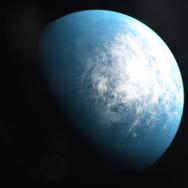For decades, a nearby star named AU Microscopii has intrigued astronomers as a possible home for planets.
Now, scientists using data from NASA’s Transiting Exoplanet Survey Satellite (TESS) and retired Spitzer Space Telescope have discovered a planet about as large as Neptune—one that circles the young star in just over a week.
The new planet, AU Mic b, is just 32 light-years from Earth. It is described in a paper published June 24 in Nature.
“Most exoplanets we know of orbit stars that are billions of years old,” said astrophysicist Emily Gilbert, a graduate student at the University of Chicago and co-author of the paper. “This new discovery is unique because this star is only about 20 million years old, so it allows us to study what happens to planets in the early stages of their lives.”
Still surrounded by a disk of debris left over from its formation, AU Microscopii offers a one-of-kind laboratory for studying how planets and their atmospheres form, evolve and interact with their stars. Known as AU Mic for short, the star lays at the center of a touchstone system, which can help further research into the formation and evolution of stars and planets for decades to come.
“AU Mic is a young, nearby M dwarf star. It’s surrounded by a vast debris disk in which moving clumps of dust have been tracked, and now, thanks to TESS and Spitzer, it has a planet with a direct size measurement,” said co-author Bryson Cale, a doctoral student at George Mason University. “There is no other known system that checks all of these important boxes.”

AU Mic is a cool red dwarf star with an age estimated at 20 million to 30 million years, making it a stellar infant compared to our sun, which is at least 150 times older.
The system is located in the southern constellation Microscopium, part of a nearby collection of stars called the Beta Pictoris Moving Group. That group takes its name from a bigger, hotter star that harbors two planets and is likewise surrounded by a debris disk.
Although the AU Mic and Beta Pictoris systems are the same age, their planets are markedly different. The planet AU Mic b almost hugs its star, completing an orbit every 8.5 days. Its mass is nearly 58 times greater than that of Earth. Beta Pictoris b and c, however, are both at least 50 times more massive than AU Mic b and take 21 and 3.3 years, respectively, to orbit their star.
“We think AU Mic b formed far from the star and migrated inward to its current orbit, something that can happen as planets interact gravitationally with a gas disk or with other planets,” said co-author Thomas Barclay, an associate research scientist with the University of Maryland and NASA’s Goddard Space Flight Center.
“By contrast, Beta Pictoris b’s orbit doesn’t appear to have migrated much at all,” he added. “The differences between these similarly aged systems can tell us a lot about how planets form and migrate.”
Detecting planets around stars like AU Mic poses a particular challenge. These stormy stars possess strong magnetic fields and can be covered with starspots—cooler, darker and highly magnetic regions akin to sunspots—that frequently erupt powerful stellar flares. Both the spots and their flares contribute to the star’s brightness changes.
“This new discovery is unique because this star is only about 20 million years old, so it allows us to study what happens to planets in the early stages of their lives.”
In July and August 2018, when TESS was observing AU Mic, the star produced numerous flares, some of which were more powerful than the strongest flares ever recorded on the Sun. The team performed a detailed analysis to remove these effects from the TESS data.
When a planet crosses in front of its star from our perspective, an event called a transit, its passage causes a distinct dip in the star’s brightness. TESS monitors large sectors of the sky for 27 days at a time. During these long stares, cameras regularly capture snapshots that allow scientists to track changes in stellar brightness.
Regular dips in a star’s brightness signal the possibility of a transiting planet. Usually, it takes at least two observed transits to recognize a planet’s presence.
Because the amount of light blocked by a transit depends on the planet’s size and orbital distance, the TESS and Spitzer transits provide a direct measure of AU Mic b’s size. Analysis of these measurements show that the planet is about 8% larger than Neptune.

This method provides a snapshot of the size of the planet, but scientists must combine this data with a different kind of observation to know how heavy it is—and thus whether it’s a rock or gas planet.
As a planet orbits, its gravity tugs on its host star, which moves slightly in response. Sensitive instruments on large telescopes can detect the star’s radial velocity, its motion to-and-fro along our line of sight. Combining observations from the W. M. Keck Observatory and NASA’s InfraRed Telescope Facility in Hawaii and the European Southern Observatory in Chile, the team concluded that AU Mic b has a mass smaller than 58 Earths.
“There is an additional candidate transit event seen in the TESS data, and TESS will hopefully revisit AU Mic later this year in its extended mission,” Plavchan said. “We are continuing to monitor the star with precise radial velocity measurements, so stay tuned.”
AU Mic b is featured in a new NASA poster available in English and Spanish, part of a Galaxy of Horrors series. The fun but informative series resulted from a collaboration of scientists and artists and was produced by NASA's Exoplanet Exploration Program Office.
—Adapted from an article originally posted by NASA’s Goddard Space Flight Center by Francis Reddy.









